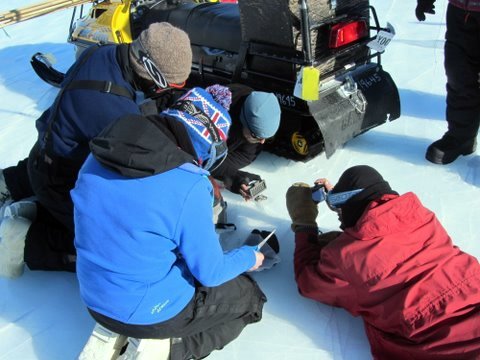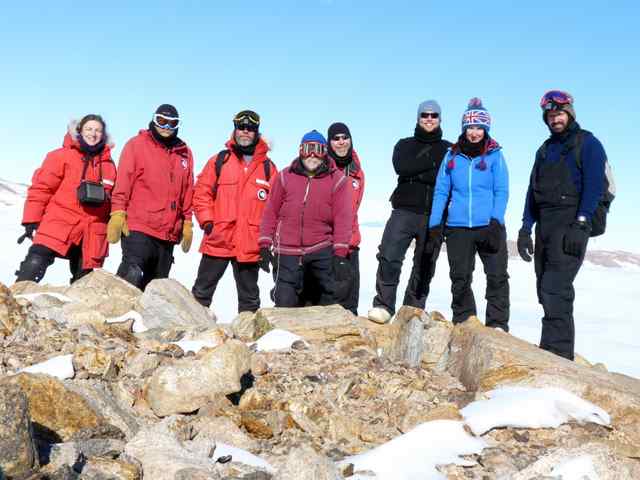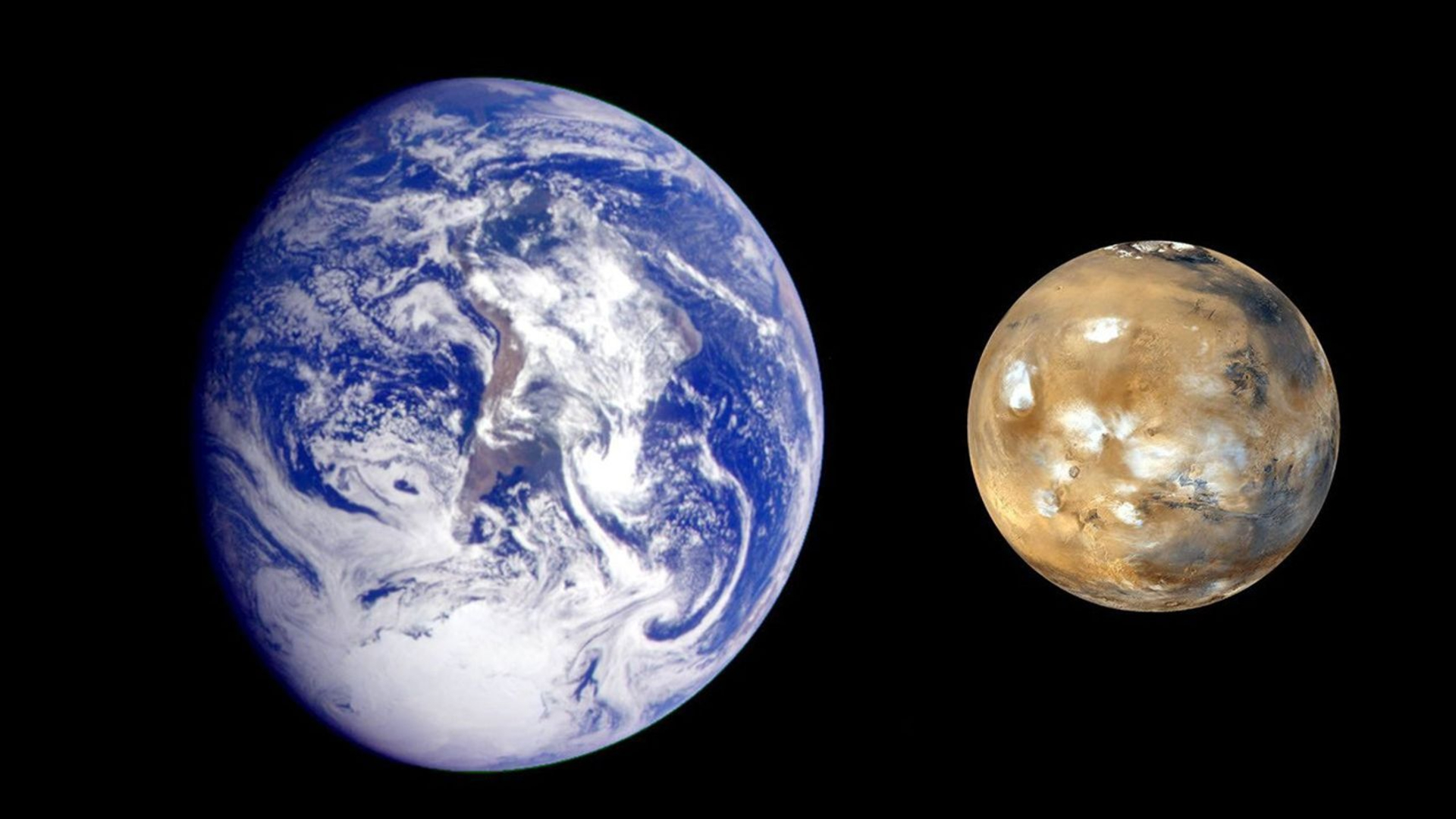
Hundreds of Meteorites Uncovered in Antarctica

A gang of heavily insulated scientists has wrapped up its Antarctic expedition, with its members thawing out from the experience, but pleased to have bagged more than 300 space rocks.
They are participants in the Antarctic Search for Meteorites program, or ANSMET for short. Since 1976, ANSMET researchers have been recovering thousands of meteorite specimens from the East Antarctic ice sheet. ANSMET is funded by the Office of Polar Programs of the National Science Foundation.
According to the ANSMET website, the specimens are currently the only reliable, continuous source of new, nonmicroscopic extraterrestrial material. Given that there are no active planetary sample-return missions coming or going at the moment, the retrieval of meteorites is the cheapest and only guaranteed way to recover new things from worlds beyond the Earth. [Photos: Asteroids in Deep Space ]
Special place
"It has been another interesting season at Miller Range," said Ralph Harvey, associate professor in the department of Earth, Environmental and Planetary Sciences at Case Western Reserve University in Cleveland, Ohio.
"The place is special for us because we seem to find meteorites everywhere , in every little nook and cranny, almost unpredictable," Harvey told SPACE.com. "And it did it again ... lots of places we checked out just to be complete proved to have dozens of specimens."
Harvey is the principal investigator for the ANSMET program. "I've been leading field parties since 1991 and I think this year marks my 25th overall with the program," Harvey said.
Breaking space news, the latest updates on rocket launches, skywatching events and more!
Harvey likens his search for meteorites to a farmer who's used to harvesting corn in a field finding it growing in the barn, in the garage, in the basement and other surprising spots.
The meteorite hunting wasn't all smooth, though.
The team was held back significantly by early snowfalls that buried the meteorites. Even though a few strong windstorms cleared some of it, the whipping winds did not clear all of it, Harvey explained.
"The total number of meteorites is less than half what I would have predicted, again primarily because of that early snow hiding all the specimens," Harvey said. "We'll be going back to the Miller Range at least one more time and maybe two."
Celestial collectibles
Antarctica is viewed as the world's premier meteorite hunting ground, and for good reason.
While meteorites fall in a random fashion all over the globe, the East Antarctic ice sheet is a "desert of ice," a stark scene that enhances the likelihood of finding meteorites, which are usually undisturbed and stand out against the background.
In the just-concluded search, the team's bounty of celestial collectibles brought the total number of meteorites found in ANSMET history to 20,000. [Hunting for Space Rocks: Q&A with Geoff Notkin of 'Meteorite Men']
Along with Harvey, the meteorite hunters are:
John Schutt, an ANSMET mountaineer for over 30 years who once again played that role. He recently got an honorary doctorate recognizing his contributions to planetary science.
Jim Karner, a postdoctoral researcher working with the ANSMET program and a specialist in Martian meteorites from Case Western Reserve. He's a veteran of four ANSMET expeditions.
Christian Schrader, a geologist from NASA Marshall Space Flight Center in Huntsville, Ala., who has done significant rock work, particularly in studying lunar meteorites.
Katie Joy, planetary geologist, most recently from the Lunar and Planetary Institute in Houston, Tex., and a lunar meteorite researcher.
Anne Peslier, a planetary scientist from NASA's Johnson Space Center in Houston who has done a great deal of work on Martian meteorites.
Jake Maule, a planetary scientist, recently of Carnegie Institute in Washington, D.C., with a specialty in astrobiology.
Jesper Holst, a Ph.D. student studying planetary geochemistry at the University of Copenhagen.
Tim Swindle, a planetary geochemist from the University of Arizona, taking part in the second half of the season, and a veteran of several previous expeditions.
Samples and survival kits
The team members used Ski-Doo Snowmobiles to transport themselves out in the field. Each person is armed with a survival kit, meteorite gathering equipment, lots of water and food, medical kits, Iridium satellite phones and GPS devices.
Once a sample is spotted, scientists assign it an identification number. They establish its position with GPS and note the specimen's size, possible classification and any distinguishing features such as shape or fusion crust.
Researchers then collect the sample in a sterile Teflon bag, taking care to avoid contact with any mechanical or biological materials.
While the field season was in progress, these samples were inventoried and kept frozen. Upon the team's return to McMurdo Station, the U.S. scientific headquarters in the Antarctic, the meteorites were transferred to special shipping containers and sent, still frozen, to the Antarctic Meteorite Curation Facility at the Johnson Space Center in Houston.
There the meteorites are carefully removed from their sealed bags, dried to remove any attached snow or ice and stored under cleanroom conditions for future study.
Tent time
During their month-long stay, and at different camp sites, the group posted a series of dispatches from the field. Frequently, the noncooperating weather forced the team to spend lots of tent time: eating, reading, resting, writing.
"But as always in Antarctica, everything depends on the weather," wrote an upbeat Peslier, "so who knows what tomorrow will bring!"
Added another team member, "I am starting to wonder about the wisdom of having so many sugary snacks within hand's reach, literally, in our tent food box."
"Life has been good so far in camp," wrote Joy. "There has been lots of great meals, endless hot chocolate drinking and, having dug out my box of sweet treats, I have uncovered my small stash of Kendal mint cake that I have been saving for months for the trip. Yum."
In another dispatch from the ice, Schrader reported: "It was a special day for us because we collected our first meteorites. Yee haw." At the start of exploring Miller Range, he said, "we collected 15 specimens...a modest but solid start."
Snug in his tent, Maule explained: "The biggest hardship for me out here is missing my loved ones back home. Yet, all of us on the team are in the same boat and we're all pulling together for one another. This place is special and it is a real honor for us to be here."
As the Christmas holiday season neared, Maule observed: "Best wishes to everyone as the holiday season nears. We actually have a poor, stunted Christmas tree in a bucket outside the poo tent. Very festive."
In another posting. Holst wrote: "A few hours of systematic searching yielded another 14 meteorites, including carbonaceous chondrite shards...I think we all feel that we hit the jackpot today, and we are so happy that we moved camp. So now, the real hunt is on! Oh yeah!"
Click here to see the rest of the ANSMET 2011-2012 team postings.
Leonard David has been reporting on the space industry for more than five decades. He is a winner of last year's National Space Club Press Award and a past editor-in-chief of the National Space Society's Ad Astra and Space World magazines. He has written for SPACE.com since 1999.

Leonard David is an award-winning space journalist who has been reporting on space activities for more than 50 years. Currently writing as Space.com's Space Insider Columnist among his other projects, Leonard has authored numerous books on space exploration, Mars missions and more, with his latest being "Moon Rush: The New Space Race" published in 2019 by National Geographic. He also wrote "Mars: Our Future on the Red Planet" released in 2016 by National Geographic. Leonard has served as a correspondent for SpaceNews, Scientific American and Aerospace America for the AIAA. He has received many awards, including the first Ordway Award for Sustained Excellence in Spaceflight History in 2015 at the AAS Wernher von Braun Memorial Symposium. You can find out Leonard's latest project at his website and on Twitter.



